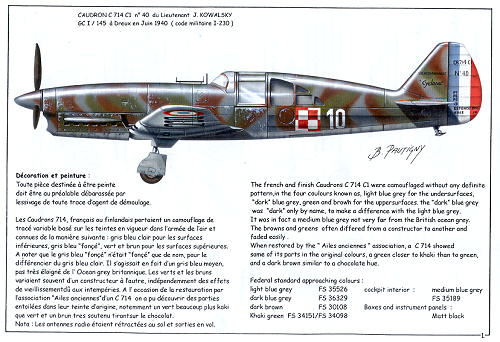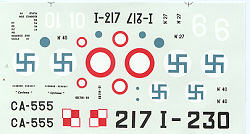
| KIT: | Battle Axe |
| KIT #: | 48BA05 |
| PRICE: | $49.00 MSRP |
| DECALS: | Three options |
| REVIEWER: | Scott Van Aken |
| NOTES: | Short run with vacuformed canopy |

| HISTORY |
The original specification that led to the C.710 series was offered in 1936 in order to quickly raise the number of modern aircraft in French service, by supplying a "light fighter" of wooden construction that could be built rapidly in large numbers without upsetting the production of existing types. The contract resulted in three designs, the Arsenal VG-30, the Bloch MB-700, and the C.710. Prototypes of all three were ordered.
The original C.710 model was an angular looking design developed from an earlier racing design series. One common feature to all of the Caudron line was an extremely long nose that set the cockpit far back on the aircraft. The profile was the result of using the 450 hp (336 kW) Renault 12R-01 12-cylinder inline engine, which had a small cross section and was fairly easy to streamline, but very long. The gear were fixed and spatted, and the vertical stabilizer was a seemingly WWI-era semi-circle instead of a more common triangular design. Armament consisted of a Hispano-Suiza 20 mm HS-9 cannon under each wing in a small pod, with an option for a third firing through the propeller spinner.
The C.710 prototype first flew on July 18th, 1936. Despite its small size, it showed great potential and was able to reach 470 km/h in testing. Further development continued with the C.711 and C.712 with more powerful engines, while the C.713 which flew in December 1937 introduced retractable landing gear and a more conventional triangular vertical stabilizer.
The final evolution of the 710 series was the C.714 Cyclone, a variation on the C.713 which first flew in April 1938. The primary changes were a new wing airfoil profile, a strengthened fuselage, and instead of two cannons the fighter had four 7.5 mm MAC 1934 machine guns in the wing gondolas. It was powered by the newer 12R-03 version of the engine, which introduced a new carburetor that could operate in negative gee.
The Armee de l'Air ordered 20 C.714s on November 5, 1938, with options for a further 180. Deliveries did not start until January of 1940. After a series of tests with the first planes it became apparent that the plane was seriously outdated. Although light and fast, its wooden construction did not permit for a better engine to be mounted, which seriously limited its vertical speed and maneuverability. Because of that the following month the Caudron was withdrawn from active service in February of 1940. In March the order was reduced to 90, as the performance wasn't considered great enough to continue production. Fifty were diverted to Finland to fight in the Winter War. Six were on their way and a further ten on the docks when the war ended and further shipments were halted. While six aircraft were delivered and assembled, they were soon found to be unreliable and dangerous to use in Finnish conditions, and were never used in combat.
On May 18 35 of Caudrons were handed over to the Polish Warsaw Squadron - the Groupe de Chasse polonaise I/145, stationed at the Mions airfield. After 23 sorties the bad opinion of the plane was confirmed by the front-line pilots. It was seriously underpowered and was no match for the enemy fighters of the epoch. Because of that, on May 25, only a week after it was introduced in active service, French minister of war Guy la Chambre ordered all of C.710's to be withdrawn from active service. However, since the French authorities had no other planes to offer, the Polish pilots ignored the order and continued to use the planes. Although the plane was hopelessly outdated compared to the Messerschmitt Me 109E's it faced, but the Polish pilots nevertheless scored 12 confirmed and 3 unconfirmed kills in three battles between June 8 and June 11, losing 9 in the air and 9 more on the ground. Interestingly, among the planes shot down were four Dornier Do 17 bombers, but also three Messerschmitt Bf 109 and five Messerschmitt Bf 110 fighters.
The plane was also used by the Polish training squadron based in Bron near Lyon. Although the pilots managed to disperse several bombing raids, they did not score any kills nor did they loose any machines. By the end of June when France fell, only 53 production machines had been delivered (although the number varies, 98 is another common figure).
Other projected versions were the C.720 trainer with a 100 or 220 (75 or 164 kW) engine, the C.760 fighter with a 750 hp Isotta-Faschini inline engine, and the C.770 fighter with an 800 hp (597 kW) Renault V-engine.
| THE KIT |
 If you have ever seen a French short run kit, then this
one is pretty typical. It is molded in a greenish plastic and all comes on a
single sprue. There is no photo etch or resin included and the two canopies are
vacuformed plastic and superbly molded. The surface texture of the plastic
itself is not as rough as I've seen on previous kits, in fact, it is pretty
smooth. There are the usual plethora of ejector pin marks and towers that will
have to be cleaned up. The sprue attachment points are also rather large, though
not overly so. The lower wing section had detached itself from the sprue and
while I'd expected a few chunks from the attachment points, there were none.
If you have ever seen a French short run kit, then this
one is pretty typical. It is molded in a greenish plastic and all comes on a
single sprue. There is no photo etch or resin included and the two canopies are
vacuformed plastic and superbly molded. The surface texture of the plastic
itself is not as rough as I've seen on previous kits, in fact, it is pretty
smooth. There are the usual plethora of ejector pin marks and towers that will
have to be cleaned up. The sprue attachment points are also rather large, though
not overly so. The lower wing section had detached itself from the sprue and
while I'd expected a few chunks from the attachment points, there were none.
In order to not have the problems with mold shift that have plagued other Battle Axe kits, the thicker bits such as wheels, rudder, horizontal stabs and such are molded in two halves. General detail level is rather soft, as you'd expect from a low pressure injection molding, and the panel lines also exhibit a more 'rounded' appearance than you'd find on major manufacturer's kits. But really, it isn't bad at all and better than previous kits. Many of the parts exhibit some flash that will need to be removed as well.
The cockpit comes with a floor, seat, rudder bar, control column and side panels. There is full wheel well detail and the insides of the main gear doors also have good detail. I didn't see any problems with sink areas, even on the rather thick one-piece wing. The prop blades and spinner are separate and there is no positive alignment pin to get the blade angle right.
Instructions are two sheets of paper. On the cover is a
large profile drawing in full color of a Polish version while on the back are
the construction steps with some detail drawings. The other sheet contains the
other two  markings options and
on the back is an English translation of the construction sequence. This is very
well done and easy to follow. Apparently quite a bit of trimming of various
parts will be needed to build the kit and these are all spelled out in the
write-up.
markings options and
on the back is an English translation of the construction sequence. This is very
well done and easy to follow. Apparently quite a bit of trimming of various
parts will be needed to build the kit and these are all spelled out in the
write-up.
Markings are for two French/Polish aircraft and one Finnish version. The decals are well done and it will be interesting to see how these turn out. The French roundels have separate centers to prevent registration problems. Standard French camo in a camouflage scheme that was different every time it was applied. If doing the version with the tricolor rudder, those colors will need to be painted on and for that reason, the rudder is separate.
| CONCLUSIONS |
My personal history with French short run kits has shown that they can be built, but they take more than the usual amount of effort to produce a viable model. There are times when I wonder why I buy these things, but the truth is that I buy by subject and so was smitten again by a sexy looking airplane. I must be nuts.
| REFERENCES |
Mushroom Model Publications GC 1/145 in 1940
October 2006
Review kit courtesy of my wallet for your elucidation.
If you would like your product reviewed fairly and quickly by a site that has nearly 325,000 visitors a month, please contact me or see other details in the Note to Contributors.